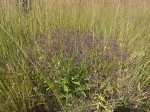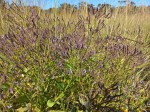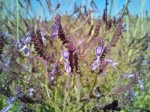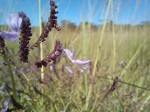Aeollanthus suaveolens
Selected images: Click on each image to see a larger version and details of the record View all images (4)
Detailed records: Display species records QDS maps by: Google Maps Point records by Google Maps
Species details: Click on each item to see an explanation of that item (Note: opens a new window)
| Synonyms: |
Aeollanthus affinis De Wild. Aeollanthus cassava G. Taylor Aeollanthus glabrifolius De Wild. Aeollanthus heliotropioides Oliv. Aeollanthus lamborayi De Wild. |
| Common names: | |
| Frequency: | |
| Status: | |
| Description: |
Annual or perhaps sometimes a short-lived perennial herb, 7–80 cm, ascending or erect. Leaves opposite, sessile or subsessile, elliptic to obovate or sometimes ovate, up to 1.3–7.5 × 0.4–2.5 cm, rounded, cuneate or slightly attenuate at the base, margin crenate or almost entire. Inflorescences lax or rather dense; spikes onesided with one flower and two dissimilar bracts at each node; bracts mostly densely hairy and often hidden by their indumentum. Corolla violet or sometimes white; tube slightly to strongly broadened towards the throat, 2.5–6 mm long; posterior lip distinctly 4-lobed; anterior lip boatshaped, 1.5–4 mm long. Fruiting calyx ± ovoid, 2.5–4.1 mm long, concave in the apical part of the abaxial side, dehiscent far below the middle; posterior lip truncate or indistinctly 3-lobed, usually slightly bent over the anterior lip; anterior lip truncate or slightly 2-lobed; basal part orbicular (when seen from above), flat above. Nutlets 1–1.2 × 0.9–1.1 mm, smooth, glossy. |
| Type location: |
Brazil |
| Notes: | |
| Derivation of specific name: | suaveolens: sweet-smelling or fragrant, a reference to the aromatic nature of the whole plant. |
| Habitat: | |
| Altitude range: (metres) | |
| Flowering time: | Mar - Apr |
| Worldwide distribution: | Widespread from Nigeria, Cameroon and Sudan through East and Central Africa south to Angola, Zambia, Botswana and northern South Africa. |
| FZ divisions: | |
| Growth form(s): | Annual. |
| Endemic status: | |
| Red data list status: | |
| Insects associated with this species: | |
| Spot characters: | Display spot characters for this species |
| Literature: |
Ntore, S. & al. (2024). Checklist of the vascular plants of Burundi Page 143. Paton, A.J. et al. (2013). Lamiaceae Flora Zambesiaca 8(8) Page 296. Setshogo, M.P. (2005). Preliminary checklist of the plants of Botswana. Sabonet Report no. 37. Sabonet, Pretoria and Gaborone Page 77. |
Other sources of information about Aeollanthus suaveolens:
Our websites:
Flora of Burundi: Aeollanthus suaveolensFlora of Zambia: Aeollanthus suaveolens
External websites:
African Plants: A Photo Guide (Senckenberg): Aeollanthus suaveolensAfrican Plant Database: Aeollanthus suaveolens
BHL (Biodiversity Heritage Library): Aeollanthus suaveolens
EOL (Encyclopedia of Life): Aeollanthus suaveolens
GBIF (Global Biodiversity Information Facility): Aeollanthus suaveolens
Google: Web - Images - Scholar
iNaturalist: Aeollanthus suaveolens
IPNI (International Plant Names Index): Aeollanthus suaveolens
JSTOR Plant Science: Aeollanthus suaveolens
Mansfeld World Database of Agricultural and Horticultural Crops: Aeollanthus suaveolens
Plants of the World Online: Aeollanthus suaveolens
Tropicos: Aeollanthus suaveolens
Wikipedia: Aeollanthus suaveolens



